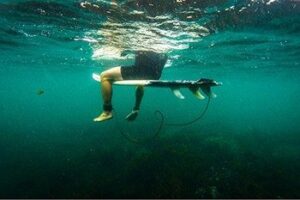
Excerpt from the book: Chapter 13: The Dolphins
“Dolphins! I see dolphins!”
My favorite creatures appeared; it would be a wonderful day. The sky was blue, the ocean calm and a dolphin calf had just breached the surface along the shores of Kenya.
“Good spotting,” said Jane who worked with the Watamu Marine Association (WMA).
I have an affinity with dolphins. For some reason, I can sense these mammals and know where to look before they surface. Jane was sitting on the port side of the wooden box-like boat, clipboard in hand, noting the time of day and the location of the sighting.
“Are you getting this, Mike?” she asked.
Mike was a local Kenyan. His job on this conservation project was to photograph the dolphins’ dorsal fins as they came up for air.
From this, a database of the pod was established and each dolphin was given a photo ID which helped monitor their numbers, behavior and how, within the Malindi-Watamu Marine National Park and Reserve, they were being impacted by the threats they faced.
I was both excited and somewhat anxious as I bent over the side of the boat. My toes were straining to keep contact with the deck, my bruised belly was flattened over the four-inch wooden gunwale, my head skimmed the waterline, while my arms grasped the video camera below the surface.
We were hoping for a live shot underwater as the dolphins passed nearby.
What is it about dolphins that make us smile? It doesn’t matter whether they are bottle-nosed, spinner, spotted or striped as soon as they surface our joy goes up the scale.
Did we always feel that way? Or was it the result of a TV show we saw as children? A fairy tale that follows the adventures of two kids and their pet dolphin, who lived in the lagoon at the end of their dock. Following the popularity of Flipper, the industry that holds dolphins in captivity exploded. People the world over now want to pet them, feed them and hang out of their dorsal fins. With hundreds of dolphinariums worldwide, are these programs educational or are dolphin tricks just big business?

The single most determined activist, who has made it his life’s mission to free dolphins in captivity, has got to be the man who believes he created the problem in the first place: Ric O’Barry. As the trainer on the TV show, he was not only responsible for capturing the five dolphins that played Flipper but for teaching them to jump, twirl and tail-walk on cue.
In the Oscar-winning documentary The Cove, Ric explains how he spent ten years contributing to the building of this industry and the rest of his life trying to tear it down. Most of the dolphins people kiss and stroke in what O’Barry refers to as the “Abusement Parks” throughout the world, are captured during an annual hunt in Taiji, Japan. Those not chosen to be shipped to seaquariums are slaughtered, out of sight. Once you watch the movie, the blood-red water of the scenic cove is a sight you can never un-see.
What causes a man who makes a lucrative living as an animal trainer to undergo such a radical shift? The show had wrapped up, the props returned to storage, and the dolphins back to the tank. Dolphins are sonic beings. On any given day, depending on their food supply, they can travel forty to fifty nautical miles.

They socialize in groups. A concrete tank or artificial lagoon is not the open water in which they were born. Sunburned and depressed, Cathy, the primary dolphin who’d played Flipper, died. Unlike humans, whose subconscious takes care of breathing, dolphins inhale on purpose. Ric said he was right beside her when she took her final breath and sank to the bottom of the tank.
He called it suicide.
From that moment on, he vowed to spend the rest of his life freeing as many captive dolphins as he could, much of his effort being centered around that one cove in Japan.
Once they are captured and shipped, that’s when you and I, unknowingly, play our part. I’ve done it. Maybe you’ve done it, or you know someone who has. We purchase a ticket to the dolphin experience, thereby creating the demand.
According to the World Society for the Protection of Animals (WSPA) one of the ways to conscientiously “commune with dolphins is from the deck of a dolphin-watching operation that follows a responsible code of conduct.”
For these reasons, having forgiven myself for the small part I had previously played in keeping dolphins in captivity by buying tickets for the shows, I had come to Watamu Marine Association to volunteer my time and learn about their work.
 Niamh Mcanally (pronounced “Knee-if Mack-an-alley”) is an Irish-born bestselling author, keynote & corporate speaker, and former TV director. Niamh has also been published in The Journal, Sail, The Irish Times Abroad, Writing. ie and Subsea magazines. Her new book Following Sunshine is the winner of the 2024 Literary Titan Gold Award for Nonfiction
Niamh Mcanally (pronounced “Knee-if Mack-an-alley”) is an Irish-born bestselling author, keynote & corporate speaker, and former TV director. Niamh has also been published in The Journal, Sail, The Irish Times Abroad, Writing. ie and Subsea magazines. Her new book Following Sunshine is the winner of the 2024 Literary Titan Gold Award for Nonfiction
- Following Sunshine and Dolphins - October 22, 2024
- Housesitters Unite!Here’s a Great Way to Stay Free - October 21, 2024
- Tangier Tastes: Morocco’s Culinary Center - October 18, 2024






